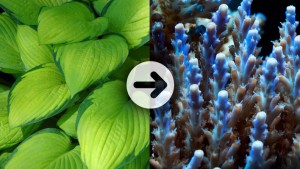Having once worked in the nursery and landscaping business, it often occurs to me that there are a surprising number of similarities between terrestrial gardening/landscaping and reefkeeping. I would even suggest that, in some ways, reefkeeping has more in common with gardening than with maintaining a freshwater or marine fish-only aquarium. Many of the elements terrestrial “green thumbs” must deal with in order to succeed with gardening have analogs in the reefkeeping hobby, and I’m convinced that if gardeners could be persuaded to give reefkeeping a try, they might just discover they have a certain knack for nurturing coral “gardens” as well.
Now, I fully understand that corals aren’t plants and that this analogy only goes so far. Nonetheless, the following factors that are important in both gardening and reefkeeping might just strike a chord with some of you horticulture aficionados out there:
Proper spacing
Knowing the height, spread, and particular growth habit of a plant is critical in determining where in the landscape it should go and how far to space it from other plants. Similarly, reefkeepers need to know the potential size, growth habits, and defensive capabilities of corals and other sessile invertebrates (e.g., plating, encrusting, sweeper-tentacle-producing, etc.) so they can space them out properly in order to prevent them from stinging, shading out, physically growing onto, or otherwise harming/impeding one another.
Proper sun exposure
Sure, gardeners don’t have to pay the long dollar to replicate natural sunlight the way most reefkeepers do, but like reefkeepers, they do need to research and adhere to the lighting requirements of the specimens they choose.
Just as gardeners soon discover that plant species vary considerably in their lighting needs (ranging from shade-loving hostas to sun-hungry spireas), reefers quickly learn that some sessile invertebrates, such as Acropora, prefer relatively intense lighting; others, such as mushroom polyps, favor more subdued lighting schemes; and still others fall somewhere in between these two extremes.
Proper wind exposure
Okay, I’ll admit there’s no wind underwater, but there is most assuredly an analogous element: current. It’s a very small leap from planting terrestrial plants where they’ll receive an appropriate level of wind exposure (for example, placing azaleas and other broadleaf evergreens where they’ll have some protection from drying winds) to positioning different sessile invertebrates where they’ll get a species-appropriate amount of current.
Weeds and pests
Just as gardeners are ever poised to do battle with dandelions, chickweed, ground ivy, slugs, aphids, whiteflies, Japanese beetles, and a host of other weeds and pests, reefkeepers have their hair algae, bubble algae, cyanobacteria, Aiptasia and majano anemones, Asterina sea stars, rust-colored flatworms, and other pesky organisms to contend with.
Go from green to saline!
So, gardeners, why not dip that green thumb in some salt water and give reefkeeping a try? It might just open up an exciting new world for you. Besides, you’re halfway there already!



